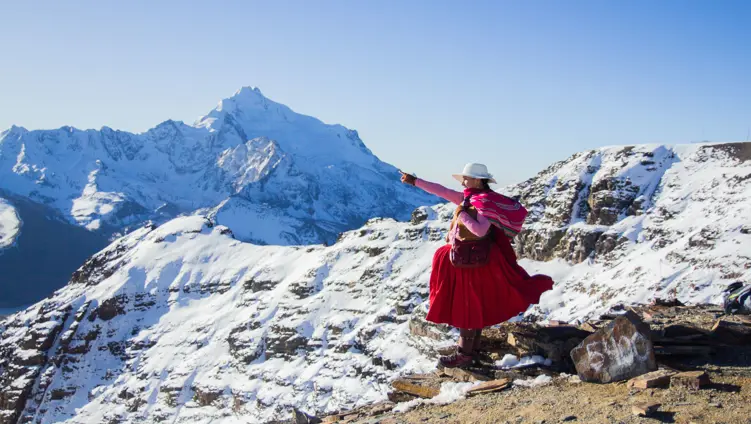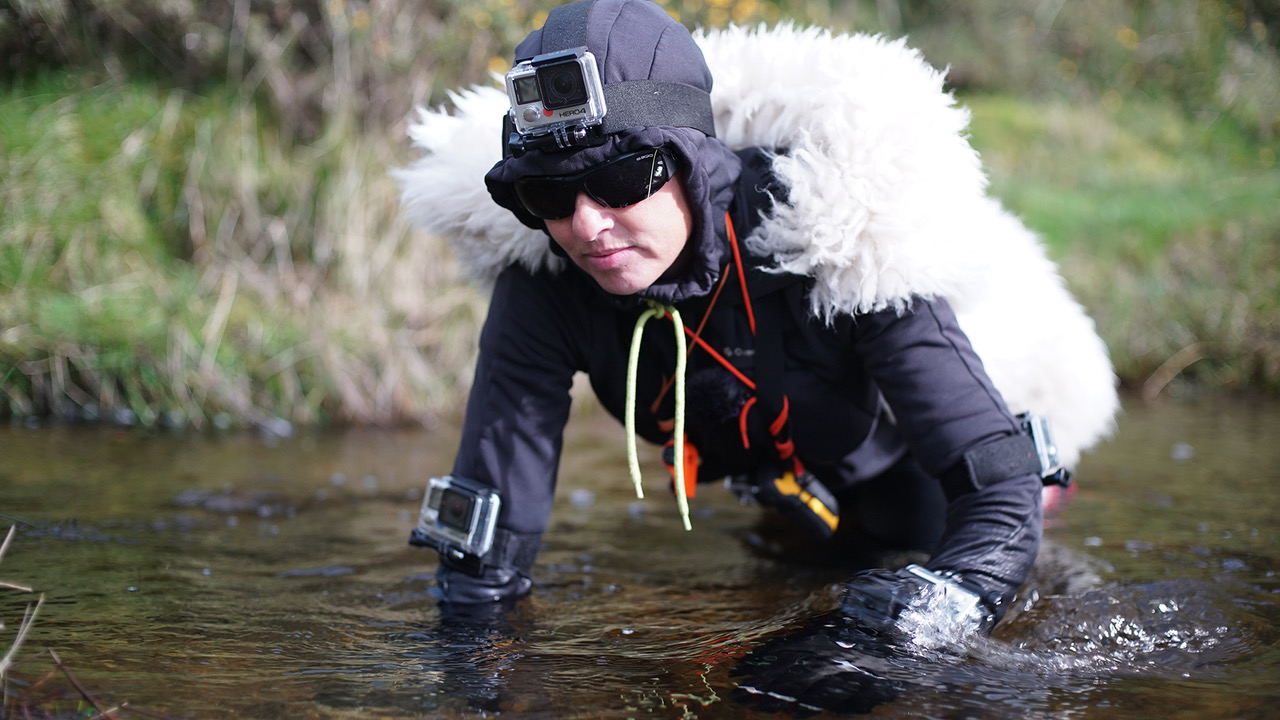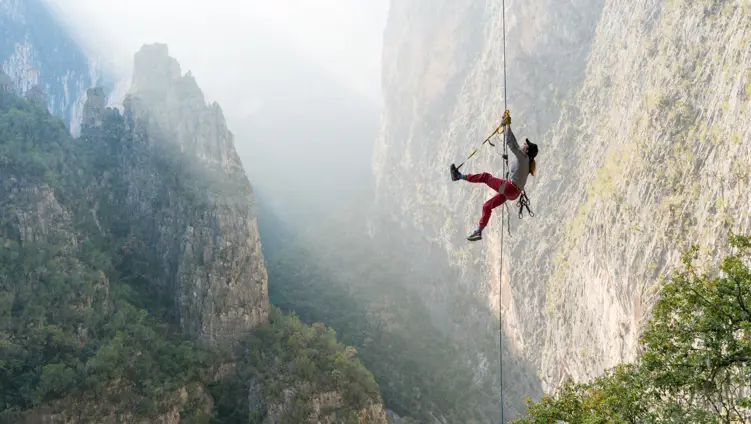
Miranda Whall studied at the Royal Academy Schools, London and Goldsmiths, University of London. She has been a full-time lecturer and the director of the Creative Arts Degree course at Aberystwyth University since 2006. She has exhibited her work internationally for many years and has been the recipient of many Arts Council England and Wales Grants and Residencies. Her multiplicitous crawling, staring, walking, growing and travelling practice is a practice of getting close, of becoming a creature of the mud, the matter and the flesh of the world, an exploration of our need to develop a non-hierarchical, more ethical and more complex relationship to our environment and to our relationship to non–human others: plants, animals and technology simultaneously. Through performance and film Whall develops an economical, conscious, cultural, meditative, radical, transformative and socially engaged practice. Our Editor Sam spoke to her about her work, and whether it classifies as ‘adventure’.
I first learned about Miranda Whall’s work through a photo of her dressed as a sheep and crawling through the Welsh countryside festooned with GoPros. It seemed an adventure of a very different sort, and I was keen to learn more.
This, it turns out, is not Miranda’s only curious interaction with animals. She has read her personal diaries aloud to a field of cows, getting particularly close to a bullock. She has also shouted at jellyfish - “Will you miss me when I’m gone?” - and bragged to a sea anemone about all the things she is good at, “making a mockery of our own human nonsense,” as she puts it.
More than anything, she says her work is “about trying to get close” to nature in order to go beyond the hierarchical, often exploitative relationship we have with natural environments in playful, surreal and, arguably, adventurous ways.
“I think we’ve gotten very lost in how to be with nature,” she says. She references adventure-sport culture - a more standard understanding of what adventure looks like. “It speaks volumes about how human beings are with nature,” she reflects. “We have to somehow use it for our own benefit, our own pleasure. It’s all about this anthropocentric approach.”
'I think we’ve gotten very lost in how to be with nature ... We have to somehow use it for our own benefit, our own pleasure. It’s all about this anthropocentric approach.'
Photo by Hannah Mann

One manifestation of this effort is Miranda’s penchant for staring at nature. This strand of her work includes a project for which she stared at an oak tree on the hour, every hour, for 24 hours. As well as an intensive effort to intimately appreciate an aspect of the landscape, these stares double as an inner journey. “While I stared at something that seemed to be relatively stationary, I ended up staring at myself,” she says. “You could argue we are the most unknown landscape to ourselves, which is one of the reasons we travel outwards, so as to avoid travelling inwards. Or we travel outwards in order to travel inwards.”
Dressing as a sheep, in this context, suddenly makes a lot more sense. “I suppose I'm just trying, in my own little way, to weave a path around these hierarchical relationships,” she continues. There is an echo of the Buddhist notion of ego-death in the way she encapsulates her desire to de-centre humans by inhabiting the perspective of other living beings: “when we become nothing, we become everything.”
Miranda isn’t necessarily trying to make any explicit arguments here, or to “prove or resolve” anything. She is, like many artists, comfortable in the “grey”. But the meaningful attempt to see the world from other beings’ perspectives has clear relevance to serious, even existential environmental issues: what we consume, how we manage land, our attitudes to biodiversity and the climate crisis. “I do believe that the plants and rivers and the sea should have rights,” Miranda says. “We have to be accountable to the destruction of these things.”
'I suppose I'm just trying, in my own little way, to weave a path around these hierarchical relationships'
Photo by Ash Calvert

Adventure is often pitched as going deep into the outdoors, and about challenging ourselves and stepping into the unknown in the process. Miranda’s sheep adventure, in its highly distinctive way, meets this definition more deeply than most other adventures going.
Nan Shepherd, the Scottish author of the revered account of her journeys into the Cairngorms, The Living Mountain, is partly to thank here. Shepherd’s work - particularly her notion of going “deeply into a place by briefly being in it like something else” - has greatly impacted Miranda’s practice.
“Her book is just so dense,” she continues. “Every single line is really excruciatingly intense, it’s almost an impossible read!” But the book is pointed, as well as beautiful. “She was very much mocking the classic male expedition leader that wanted to reach the top of the peaks,” Miranda continues. “The goal was: ‘Hang on, why not just stay around the plateaus and hang out?’”
This beauty and insight, though, were almost lost to the world. “It’s amazing to think she did it without an audience. I mean it wasn't published. She put it at the bottom of a drawer and forgot about it. It wasn't done for anyone. We’re so audience-obsessed now. I always love the idea that people just do things for the sake of it. Does anyone do that anymore?”
'It’s amazing to think she did it without an audience. I mean it wasn't published. She put it at the bottom of a drawer and forgot about it. It wasn't done for anyone.'
Photo courtesy of Miranda Whall

The genesis of Crossed Paths, the project for which Miranda dressed as the sheep, has roots in a particular part of The Living Mountain. “There is a piece in it where she talks about standing and looking between your legs upside down,” Miranda recalls. “At that point you see the earth totally differently, as if for the first time.” Shortly after experimenting with this technique in the Welsh mountains, Miranda phoned a friend enquiring about a sheep fleece. “Before I knew it I was crawling … Like a sheep? As a sheep? Not pretending to be a sheep, but just putting the fleece on as an access point.”
The Crossed Paths project has since evolved to encompass further crawls dressed as four animals: a sheep, a badger, an otter and soon a mountain hare - all chosen because they are in conflict with humans in various ways. The project also features creative commissions by a poet, writer, photographer, documentary filmmaker, and eight composers and musicians.
What is it like, crawling through muddy countryside as an animal?
“When I was in the landscape alone, I felt really empowered and free,” Miranda reflects. “And then, when I was on the concrete, and there might be a human around, I felt ridiculous and embarrassed and stupid.” She describes a heightened sense of smell, too. “It's really invigorating and exhilarating. I've described it as a meeting place - an exchange, or halfway point, between human being and Other.” Exhilarating, that is, until the GoPro batteries died or the pain became too much.
Miranda absolutely feels these journeys have been adventures. “For me adventure is anything new. Like a new thought, a new path. It's the uncharted. The tiniest thing is an adventure if it’s new.”
Her crawls have, in a sense, been tiny. “God, It felt so epic to me,” she laughs. When she looked at her GPS tracker, though, “it was just a tiny little line … That difference is amazing. Even when I stood up after the crawl I’d say ‘Jesus, did I only get that far?'”
'Even when I stood up after the crawl I’d say ‘Jesus, did I only get that far?''
Photo by Hannah Mann

It seems this sense of adventure is alive in the art students Miranda teaches. Not what we might classically consider the adventurers of the future, perhaps, but young people engaged with ‘land art’ and with a new environmental awareness. “The students find it incredibly problematic … so arrogant and insensitive to the earth,” she says of the famous land-art generation of the 1970s.
“I had one student last year who literally wouldn't leave a mark, wouldn’t touch the moss,” she recalls. “It’s very encouraging in a way to see how super-sensitive people are about their impact on the earth. Which is weird actually, because maybe they feel okay to make an impact in an urban environment, but as soon as they go into the natural environment they become over-sensitive maybe.”
Land art, or trying to inhabit the perspective of other living beings as best we can, will not solve our environmental problems alone. But if we are to take the idea seriously that adventure, however we define it, can be harnessed for social and environmental good, creative efforts to engage deeply with the landscape must form part of that conversation. As Miranda says: “If you do something in the landscape now, you have to have that environmental agenda. It can no longer be gratuitous.”
References and recommendations
- Nan Shepherd’s The Living Mountain.
- Tehching Hsieh, a Taiwanese artist famous for five remarkable year-long pieces. The first involved locking himself in a small wooden cage - furnished only with a sink, lights, a bucket and a single bed - and forbidding himself to talk, read, write or listen to radio and television for the entire year.
- Marina Abramovich, The Artist Is Present, in which she sat silently at a wooden table, holding the eye contact of strangers for eight hours a day for three months.
- Olafur Eliasson, who responded to climate change in 2018 by transporting centuries-old Greenland icebergs to London.







